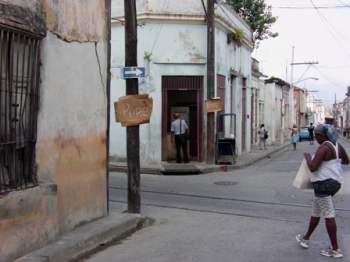Santiago: Somebody’s Got to Be Kidding?
Alfredo Fernandez

Last month I visited my hometown of Santiago de Cuba. When walking through the streets of my native city, what unavoidably came to my mind was the post by my Havana Times colleague Dariela Aquique, an entry titled Santiago de Cuba: Decadent Urbanism.
Dariela is a Santiagoan in situ, meaning that she still lives in that city and therefore endures its daily deterioration. That’s why her initial entry in Havana Times was an article in which she showed her concern and sense of impotence related to a city that she loves and that she’s watching collapse before her eyes.
Though in her entry I never thought that she was exaggerating, I didn’t fully appreciate how alarming this issue of the city’s physical decline really is.
I also remembered that a regular Havana Times in Spanish reader and commentator, “Otrodiferente” (a Santiagoan living in exile in Berlin), wrote that the Republican-era building in which he was born (identified as once situated on the corner of the Marti and Cuavitas streets) no longer exists because it collapsed – taking the life of a child.

Today that central downtown site remains empty. This is an urban irony for those that know this building had been painted during a visit by Venezuelan President Hugo Chavez to Santiago.
Walking through the streets of my adolescence, I was shocked when I saw that the dangerous intersection of San German and Calvary streets lacked stop signs on the corners. Fortunately the area residents had the good thinking to put up cardboard signs in an attempt to prevent accidents.
When I got to the downtown area I was again taken aback, but not so much by the deterioration of the El Oriente theater/cinema, not even by the Imperial and Venus hotels, today both in ruins.
What hit me was the irony of a sign fixed to the balcony of the House of Trova that warned any passerby of the danger of collapse that this structure poses, though the sign made no attempt to dissuade anyone from coming into the business to patronize its services – neither those on its first floor nor those at the top of the building.
What was worse was the building on the same corner as the House of Trova, a 19th-century building that has frankly decayed to a state of complete disrepair.

As a Santiagoan, I would hate to see that building ending up like “Otrodiferente’s” place of birth, because its location on Heredia and San Felix streets is vital to the city; it’s just beside the house where the first romantic poet of the Americas was born, Jose Maria Heredia, and barely 50 yards from Cespedes Park, the cultural center of the city.
I’d like to know if someone is pulling my leg, because a few days ago, during the ceremony marking the 500th year since the founding of the city of Baracoa I, saw on national television where the City Historian of Santiago was being awarded in recognition of the revitalization work realized. Witnessing such a farce I was baffled, because — architecturally speaking — Santiago’s historic district has never been in worse condition than it is today.
A year ago when I was going through Facebook, I found a website that caught my attention for its subtlety and finesse. It produced a wave nostalgia in me because it made me remember times of my adolescence that will never return.
The website in question is named “Santiagoans Around the World” (Spanish: Santiagueros por el mundo). The introduction of the page has writings by someone who truly knows Santiago, especially those of my generation from there: “Those who have found themselves waking up at dawn outside the Moncada Barracks on July 26 after ‘carnivalling’ away the whole night, or those of us who buy hayacas (tamales), which are always from San Luis.”
In short, the site saddened me to no end, and it made me sadder even more when I saw the photos of the city in the past, when it was in its full splendor.

I should clarify that parallel to the patrimonial deterioration of the city, there is in fact a rebirth effort underway adjacent to the historic district. Projects are being implemented by the provincial government to revive and fix up the Boulevard and Victoriano Garzon Avenue.
Only for the life of me I can’t figure out why this whole revival campaign is being carried out on the outer edge of the Historic District.
That’s why when they publically recognized the “City Historian” the other day, I — as a Santiagoan — couldn’t help but say to myself: “Somebody’s gotta be kidding?”






I completely agree with Luis.
I have been to cuba, and most of the people support the government. I’ve also talked to people that don’t, and I can assure you that they do not have to hide.
One question: if internet in Cuba is as controlled as you say it is, how is it possible for you to write this blog? In one entry you say that the government filters the e-mails. You have more than 2000 followers in facebook, so I assume quite a lot of people reads this blog. Not precisely hard to find for anyone, and for the government neither, am I wrong? And yet it’s still open and operating…
Wow not one mention of the EMBARGO. You make it seem that The Cubans in charge are stupid and spending the money to fix the city in WHAT? What Cuba has done in spite of the USA’s best efforts to keep the island down should be a testament to the power of Cubans. Any other country would have given up.
How can anyone complain about Cuba without bringing up the Embargo.